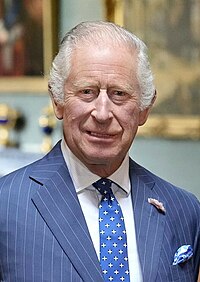
Back ملكية نيوزيلندا Arabic Новазеландская манархія Byelorussian Новазэляндзкая манархія BE-X-OLD Monarkiezh Zeland-Nevez Breton پاشایەتیی نیوزیلاند CKB Det newzealandske monarki Danish Μοναρχία στη Νέα Ζηλανδία Greek پادشاهی نیوزیلند Persian Monarchie néo-zélandaise French המלוכה של ניו זילנד HE
| King of New Zealand | |
|---|---|
| Te Kīngi o Aotearoa (Māori) | |
 | |
| Incumbent | |
 | |
| Charles III Tiāre te Tuatoru (Māori) since 8 September 2022 | |
| Details | |
| Style | His Majesty (Māori: Te Arikinui) |
| Heir apparent | William, Prince of Wales |
 |
|---|
|
|
The monarchy of New Zealand[n 1] is the constitutional system of government in which a hereditary monarch is the sovereign and head of state of New Zealand.[3] The current monarch, King Charles III, acceded to the throne following the death of his mother, Queen Elizabeth II, on 8 September 2022 in the United Kingdom.[4] The King's elder son, William, Prince of Wales, is the heir apparent.
The Treaty of Waitangi between Queen Victoria and Māori chiefs (rangatira) was signed on 6 February 1840. This laid the foundation for the proclamation of British sovereignty over New Zealand on 21 May 1840; the British monarch became New Zealand's head of state. The country gradually became independent from Britain and the monarchy evolved to become a distinctly New Zealand institution, represented by unique symbols. The individual who is the New Zealand monarch is currently shared with 14 other countries (realms) within the Commonwealth of Nations, in each of which the monarchy is legally separate. As a result, the current monarch is officially titled King of New Zealand (Māori: Kīngi o Aotearoa) and, in this capacity, he and other members of the royal family undertake various public and private functions across the Realm of New Zealand. The King is the only member of the royal family with any constitutional role.
All executive authority is vested in the King, and his assent is required for parliament to enact laws and for letters patent and orders in council to have legal effect. However, the King's authority is subject to the conventional stipulations of constitutional monarchy, and his direct participation in these areas of governance is limited.[5] Most of the related powers are instead exercised by the elected members of parliament, the ministers of the Crown generally drawn from amongst them, and the judges and justices of the peace. Other powers vested in the King, such as dismissal of a prime minister, are significant but are treated only as reserve powers and as an important security part of the role of the monarchy.
Since the monarch resides in the United Kingdom (the oldest Commonwealth realm), most of the royal constitutional and ceremonial duties within the Realm of New Zealand are typically carried out by his or her representative, the governor-general of New Zealand.[6]
The role of the monarchy is a recurring topic of public discussion.[7] Some New Zealanders think New Zealand should become a republic with a New Zealand resident as the head of state, while others wish to retain the monarchy.[8]
- ^ Shore & Kawharu 2014, p. 17
- ^ Office of the Governor-General of New Zealand. "On the Constitution of New Zealand". Retrieved 29 June 2017.
- ^ Elizabeth II (13 December 1986), Constitution Act 1986, 2.1, Wellington: Parliamentary Counsel Office (New Zealand), retrieved 30 December 2009
- ^ Department of the Prime Minister and Cabinet (29 September 2022). "Accession of King Charles III – a Official Information Act request to Department of the Prime Minister and Cabinet". Retrieved 25 October 2022 – via FYI.org.nz.
- ^ Cabinet Office 2017, p. 3
- ^ Cabinet Office 2017, p. 7
- ^ "Changing attitudes to monarchy". NZ History. Ministry for Culture and Heritage. Retrieved 24 February 2018.
- ^ Cook, Megan (20 June 2012). "Royal family". Te Ara: The Encyclopedia of New Zealand. Retrieved 7 August 2019.
Cite error: There are <ref group=n> tags on this page, but the references will not show without a {{reflist|group=n}} template (see the help page).